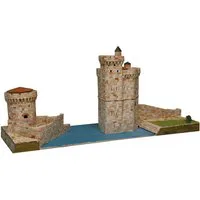Aedes Ars La Rochelle Harbour Towers Architectural Model Kit
Aedes Ars La Rochelle Harbour Towers Approximate number of pieces: 5,800 Difficulty degree: 8/10 Sizes: 630 x 230 x 270mm Scale: 1/220 These kits contain high quality ceramic pieces (which simulate the stones and the original materials), cardboard structure, glue, scenic material, and instructions. Aedes Ars produce a wide range of building sets which are used for the scale reproduction of some historical monuments such as castles, churches, bridges, and lighthouses, (some are recognised World Heritage Sites), as well as diverse miniature buildings of typical country constructions. The monument and its history. Having been in the hands of both the French and the English by turns, the city of La Rochelle negotiated its autonomy from both kingdoms. In 1372, during the reign of Charles V, the city finally became French. A major programme of fortifications strengthened the port's defences, with the rebuilding of the Saint Nicolas and Chaine towers. These two towers came to be the symbol of the renewed alliance with the King of France. The towers were also landmarks for navigation. The Saint Nicolas tower: Construction of this tower probably began in the early 14th century. Built on piles, the tower started leaning during building work and was completed around 1376. It is composed of a cylinder surrounded by four integrated turrets and a strong spur facing seawards. The tower was used both for defence purposes and as a residential quarter, with the usual areas of a Royal residence: hall, bedchamber and chapel. There were separate passageways for both functions, to avoid soldiers and residents meeting. From the 16th to the 18th centuries, the tower was used as a prison from time to time. Originally, the way into the tower was on the ground floor. The Chaine Tower: Built between 1382 and 1390, the Chaine tower was 34 metres high (currently 20 metres) with a poivriere roof. The tower was the residence of a harbourmaster until 1472. He levied the taxes due from the ships using the port and controlled the chain which enabled the port to be closed upon the orders of the mayor. The tower was destroyed by an explosion during the Fronde, when it was being used as a powder store, and remained open to the heavens for 300 years. Since 2008, the tower has housed an exhibition about the departure of emigrants to Canada.





